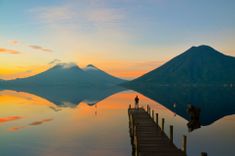Guatemala
Your Ultimate Travel Guide
Book your individual trip, stress-free with local travel experts
Why Guatemala?
Discover what makes Guatemala unforgettable





Guatemala’s volcanic landscapes offer epic adventures. Hike up Pacaya to see molten lava glowing under the stars or take on the challenge of climbing Acatenango for a sunrise view of nearby erupting Fuego. With dozens of volcanoes to explore, the country is a dream for thrill-seekers and nature lovers alike.


Guatemala is the heart of the ancient Mayan world. Explore Tikal, where towering pyramids rise above the jungle canopy, and listen as howler monkeys call through the trees. Visit lesser-known gems like Yaxhá or El Mirador for a quieter, more immersive experience. Each site offers a breathtaking connection to a civilization that shaped history.


Guatemala bursts with vibrant traditions and festivals. Wander through Chichicastenango Market, where handmade textiles, wooden masks, and local crafts create a kaleidoscope of color. Experience Semana Santa in Antigua, famous for its intricate carpets of flowers and sawdust. Everywhere you go, you’ll feel the heartbeat of Guatemala’s living culture.


Lake Atitlán is a stunning blend of natural beauty and cultural richness. Surrounded by volcanic peaks and vibrant villages, this lake is perfect for kayaking, hiking, or simply soaking in the views. Each village around the lake has its own charm, from artisan markets in San Juan to the laid-back vibes of San Pedro. It’s a place that feels like pure tranquility.

Travel tips
Plan with confidence
Unlock Guatemala with local insights
Meet the experts who make your journey special
See all Guatemala local experts →
tourism
created
travellers

tourism
created
travellers
Guatemala travel reviews
Rough Guides gets rave reviews
Trustpilot Rated 4.8/5.0Our guides were on-time, showed us a great time, and provided a wealth of information.
From the time we were picked up at the airport, we knew we had picked the right tour company. Our tour was an 8-day, 7-night tour. From the exquisite hotels they chose for us to the amazing adventures in touring, we delighted in all of it!
Everything was PERFECT!! Our guide was professional and allowed us to simply relax and enjoy an amazing vacation.
If we ever have another opportunity to visit Guatemala we would definitely choose them again!
We had an outstanding trip to Guatemala.
A fantastic experience with excellent organisation,superb guides with knowledge in all as history,nature etc
Best places in Guatemala to visit
From icons to hidden treasures












More travel inspiration
Discover Guatemala's most captivating stories
Arrange your trip, hassle-free, with local travel experts
Arrange your trip with local travel experts